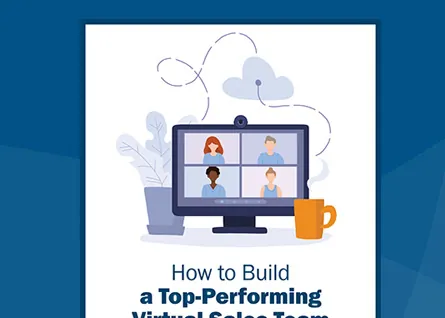Virtual Sales Trends to Pay Attention To

A few years ago, at the outset of the pandemic, many sales professionals grudgingly accepted virtual selling as a stopgap until a return to normal. Few expected it would prove such a valuable addition to their sales arsenal. Much of that was due to the steps taken by sales teams to adapt to and excel at virtual selling. As shown in our recent white paper How to Build a Top-Performing Virtual Sales Team, best-in-class teams incorporated more virtual prospecting methods, provided training and coaching, coached more frequently and regularly, offered tips on work-from-home setups, and hosted more virtual team events. Now, virtual selling is an essential element of our everyday business operations. Here are just a few of the virtual sales trends that every business should pay attention:
Trust in Virtual Grows
Early on, there was distrust. From those who thought virtual a fad, like bell bottoms, hacky sacks, and VHS, to those who expected it to be complicated, many sales pros were resistant. It’s easy to see why. In-person sales had been the standard for so long, sellers had no reason to look elsewhere, no need to fix what worked. Once the pandemic broke the system, they had no choice but to update and revise their skills and process to build trust virtually.
Today, trust in virtual is growing. According to McKinsey’s report on how COVID-19 changed B2B sales, three out of four buyers feel virtual is more effective while 65 percent of sales managers feel virtual is just as or more effective than face to face. We confirmed this trend in our own survey—over 75 percent of respondents are planning to continue to work and sell remotely in some way.
Buyers Willing to Spend
Along with the lack of trust in virtual was the mistaken belief buyers wouldn’t buy. For many, it was one thing to order a microwave online, but large-scale B2B transactions required the ancient rites of locking eyes, shaking hands, and hitting the links. This is understandable. We all feel better about spending when we are comfortable, confident, and protected. As sellers became expert at providing this level of security in virtual, tabled budgets opened. Now, McKinsey notes that 70 percent of B2B decision makers are open to remote purchases over $50,000, and 27 percent are willing to invest over $500,000.
In our own survey, launched in support of the publication of How to Build a Top-Performing Virtual Sales Team during Q3 of 2020, we learned that almost 50 percent of sales leaders had no intention of reducing their 2020 quotas because of COVID-19, confirming the bullish notion that commerce and sales would continue, despite the challenges of selling remotely. In response to a possible adjustment of quotas for 2021, more than two-thirds of sales leaders said that their quotas would be in line with 2020 quotas or even increase. As more businesses open and confidence grows, these numbers are sure to climb.
Virtual Works for Existing Clients and New Prospects
Conventional logic would dictate there has to be a difference between existing customers and new prospects when it comes to building trust and a willingness to spend in virtual. McKinsey shows a marked increase in how customers viewed the effectiveness of virtual compared to in-person interaction during the height of the pandemic. In April 2020, 54 percent of existing customers saw virtual as equal or more effective. By late April, that number jumped to 65 percent. By August, it was 75 percent, only slightly less than the 76 percent of new customers who viewed virtual as equal or more effective. So much for conventional logic in a once-in-a-lifetime global health emergency. In our own survey, we found that 78.8 percent of sales leaders said that their teams adjusted “well,” “very well,” or “extremely well” in the shift to selling virtually.
Most Companies Now Fully Virtual Capable
In our white paper How to Build a Top-Performing Virtual Sales Team, we note how, prior to the pandemic, 70 percent of respondents to our survey said their reps spent 0-20 percent of their time selling virtually. Now, 57 percent say their reps sell virtually more than 80 percent of the time. Remember, before the pandemic, many organizations saw virtual as a fad or a niche process for unique scenarios. Today, as the McKinsey report makes clear, traditional, in-person interactions are down 55 percent while video conference is up 69 percent and online chats are up 31 percent, trends that will quickly rise as confidence grows.
Video Engagement Faster, Cheaper, and Preferred
Another thing the pandemic made clear is that not all sales interactions need to be in person, with both buyers and sellers in the same room. While simple telephone calls suffice for quick check-ins and consultations, complex discussions and negotiations benefit from being in person. However, whether flying across country or driving around town, in-person meetings take up time. Also, with air or cab fare, not to mention lunches and dinners, the simplest in-person meetings can run hundreds or thousands of dollars. For many, virtual will continue to provide a middle ground. Organizations can save money and time with the convenience of video, reserving in-person meetings for when it matters most.
Transition to Hybrid
After so much time being virtual exclusive, many organizations will transition into hybrid models. Providing the rapport of in person with the ease and convenience of virtual, hybrid sales models let organizations selectively deploy their people, with one or two sellers flying out for high-level, in-person discussions and several more standing by to consult or coach on video, from either their homes or the office. This way, organizations can get the most from their sales teams without breaking the bank on unnecessary expenses or losing out on additional opportunities with extended downtime.
Though many will credit the pandemic for ushering in the age virtual selling, it was inevitable. Forward-thinking organizations were already utilizing the tools of virtual to communicate and collaborate with colleagues around the world. For many in sales, however, the pandemic provided the push needed to modernize. The technology was already there. It was simply reps trying new things or adapting their tried-and-true sales methods to the technology while their organizations and managers provided the necessary coaching. Now that sales professionals have seen the virtual future, they must keep their eyes on the prominent trends or risk falling permanently behind. For more information, download our white paper How to Build a Top-Performing Virtual Sales Team.
Updated 6/01/2024

- Account Planning (11)
- Awards (47)
- Client Testimonial (37)
- Personal Branding (19)
- Podcast (12)
- Research (72)
- Sales Career Development (87)
- Sales Coaching (157)
- Sales Consulting (137)
- Sales Culture (171)
- Sales Enablement (362)
- Sales Leadership (111)
- Sales Management (252)
- Sales Negotiation (16)
- Sales Prospecting (126)
- Sales Role-Playing (19)
- Sales Training (236)
- Selling Strategies (268)
- Soft Skills (71)
- Talent Management (95)
- Trusted Advisor (27)
- Virtual Selling (51)
- Webinar (11)


























